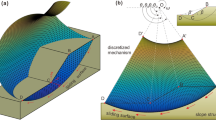Abstract
Rainfall infiltration is an important factor that leads to slope instability. In this study, a numerical model for slope is built to investigate the effects of rainfall intensity and its pattern on slope stability. Results show that rainfall intensity and its pattern significantly influence slope stability due the following instances: (1) the safety factor of slope initially decreases and then stabilizes during rainfall, which is defined as the effective rainfall days; moreover, when the rainfall intensity is less than the saturated permeability coefficient of soil, the effective rainfall days decreases with the increase of rainfall intensity. (2) Under the same rainfall intensity, the ultimate safety factor of sand slope when the effective rainfall days is reached is greater than that of the clay slope. (3) When the rainfall intensity is less than the saturated permeability coefficient of soil with the same total precipitation, a longer rainfall duration indicates a larger slope safety factor; conversely, when the rainfall intensity is greater than the saturated permeability coefficient of soil, a longer rainfall duration indicates a smaller slope safety factor.










Similar content being viewed by others
References
Ataei M, Bodaghabadi S (2008) Comprehensive analysis of slope stability and determination of stable slopes in the Chador-Malu iron ore mine using numerical and limit equilibrium methods. J China Univ Min Technol 18:488–493
Bai T, Qiu T, Huang X, Li C (2013) Locating global critical slip surface using the Morgenstern-price method and optimization technique. Int J Geomech 14:319–325
Belytschko T, Lu YY, Gu L (1994) Element-free Galerkin methods. Int J Numer Methods Eng 37:229–256
Cai F, Ugai K (2004) Numerical analysis of rainfall effects on slope stability. Int J Geomech 4:69–78
Cai F, Ugai K, Wakai A, Li Q (1998) Effects of horizontal drains on slope stability under rainfall by three-dimensional finite element analysis. Comput Geotech 23:255–275
Cheuk CY, Ng CWW, Sun HW (2005) Numerical experiments of soil nails in loose fill slopes subjected to rainfall infiltration effects. Comput Geotech 32:290–303
Cho SE, Lee SR (2001) Instability of unsaturated soil slopes due to infiltration. Comput Geotech 28:185–208
Fredlund DG, Rahardjo H (1993) Soil mechanics for unsaturated soils. Wiley, New York
Fredlund DG, Xing A (1994) Equations for the soil-water characteristic curve. Can Geotech J 31:521–532
Kim J, Jeong S, Park S, Sharma J (2004) Influence of rainfall-induced wetting on the stability of slopes in weathered soils. Eng Geol 75:251–262
Kondo K, Hayashi S (2010) Similality and generality of the Morgenstern-price and spencer methods. Landslides 34:15–23
Lang H, Chao W, Bing W, Qiumei O (2018) A new paradigm for accident investigation and analysis in the era of big data. Process Saf Prog 37:42–48
Leong EC, Rahardjo H (1997) Review of soil-water characteristic curve equations. J Geotech Geoenviron Eng 123:1106–1117
Lin H, Cao P (2014) A dimensionless parameter determining slip surfaces in homogeneous slopes. KSCE J Civ Eng 18:470–474
Lin H, Chen J (2017) Back analysis method of homogeneous slope at critical state. KSCE J Civ Eng 21:670–675
Lin H, Zhong W, Wang H, Xu W (2017) Effect of soil-water characteristic parameters on saturation line and stability of slope. Geotech Geol Eng 35:2715–2726
Morgenstern N, Price V (1965) The analysis of the stability of general slip surfaces. Geotechnique 15:79–93
Mukhlisin M, Taha MR (2012) Numerical model of antecedent rainfall effect on slope stability at a hillslope of weathered granitic soil formation. J Geol Soc India 79:525–531
Ng CWW, Lai JCH (2005) Effects of stress-dependent soil-water characteristic and damming on slope stability. J Geotech Geoenviron Eng 126:157–166
Ng CWW, Wang B, Tung YK (2001) Three-dimensional numerical investigations of groundwater responses in an unsaturated slope subjected to various rainfall patterns. Rev Can Géotech 38:1049–1062
Oh S, Lu N (2015) Slope stability analysis under unsaturated conditions: case studies of rainfall-induced failure of cut slopes. Eng Geol 184:96–103
Rahardjo H, Ong TH, Rezaur RB (2007) Factors controlling instability of homogeneous soil slopes under rainfall. J Geotech Geoenviron Eng 133:1532–1543
Rahimi A, Rahardjo H, Leong EC (2010) Effect of hydraulic properties of soil on rainfall-induced slope failure. Eng Geol 114:135–143
Shi Z, Shen D, Ming P, Zhang L, Zhang F, Zheng X (2016) Slope stability analysis by considering rainfall infiltration in multi-layered unsaturated soils. J Hydraul Eng 47:977–985
Steinberg ML (1998) Geomembranes and the control of expansive soils in construction. McGraw-Hill, New York
Styles TD, Coggan JS, Pine RJ (2011) Back analysis of the Joss Bay Chalk Cliff Failure using numerical modelling. Eng Geol 120:81–90
Tsaparas I, Rahardjo H, Toll DG (2002) Controlling parameters for rainfall-induced landslides. Comput Geotech 29:1–27
Wang YX, Guo PP, Shan SB, Yuan HP, Yuan BX (2016) Study on strength influence mechanism of fiber-reinforced expansive soil using jute. Geotech Geol Eng 34:1079–1088
Wang J, Liu J, Cao P, Liang Q, Duan J (2017) Coupled creep characteristics of anchor structures and soils under chemical corrosion. Indian Geotech J 47:521–528
Wang B, Wu C, Kang L, Reniers G, Huang L (2018) Work safety in China’s thirteenth five-year plan period (2016–2020): current status, new challenges and future tasks. Saf Sci 104:164–178
Xie YS, Cao P, Jin J, Wang M (2017) Mixed mode fracture analysis of semi-circular bend (SCB) specimen: a numerical study based on extended finite element method. Comput Geotech 82:157–172
Zhang LL, Zhang J, Zhang LM, Tang WH (2015) Stability analysis of rainfall-induced slope failure: a review. Geotech Eng 164:299–316
Acknowledgements
This paper gets its funding from Projects (51474249, 51774322) supported by National Natural Science Foundation of China; Project (2018JJ2500) supported by Hunan Provincial Natural Science Foundation of China. The authors wish to acknowledge these supports. The anonymous reviewer are gratefully acknowledged for his valuable comments on the manuscript.
Author information
Authors and Affiliations
Corresponding author
Rights and permissions
About this article
Cite this article
Lin, H., Zhong, W. Influence of Rainfall Intensity and Its Pattern on the Stability of Unsaturated Soil Slope. Geotech Geol Eng 37, 615–623 (2019). https://doi.org/10.1007/s10706-018-0631-7
Received:
Accepted:
Published:
Issue Date:
DOI: https://doi.org/10.1007/s10706-018-0631-7




